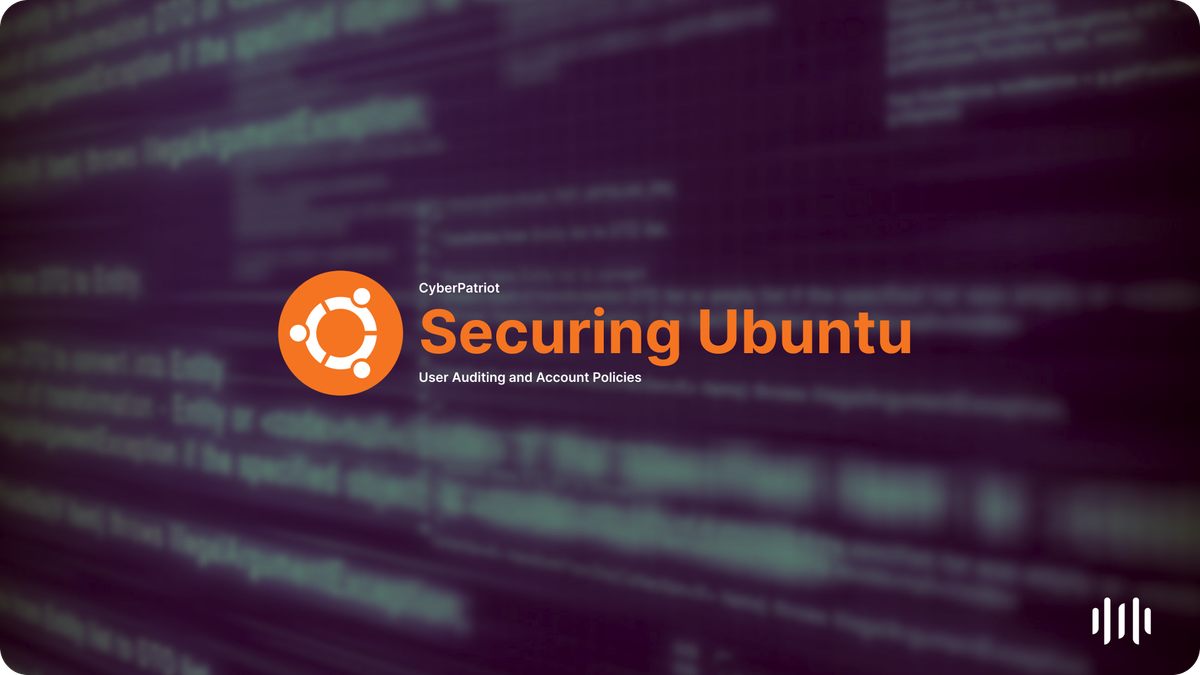Ubuntu User Auditing and Account Policies
Securing a CyberPatriot image starts with robust user management. Learn to audit accounts, disable guest access, enforce password policies, and lock down system accounts to prevent unauthorized access.

When I started with CyberPatriot, finding a straightforward guide to harden Linux systems was challenging. While forums like StackOverflow provided commands to remove users or tweak PAM settings, they often lacked clarity and context. This guide is the first in a series to simplify Linux system hardening. It provides the commands and reasoning behind them to help you learn and understand without simply following a checklist.
Basic User Auditing
User accounts are a gateway to the system, and improperly managed accounts are a common vulnerability. Let’s start by auditing and managing users to ensure only authorized accounts exist and follow best practices.
Disable the Guest Account
The guest account is often enabled by default, providing a passwordless login option. Disabling it ensures unauthorized users can’t exploit this access point.
LightDM:
sudo sh -c 'printf "[Seat:*]\nallow-guest=false\n" >/etc/lightdm/lightdm.conf.d/50-no-guest.conf'GDM3:
sudo sed -i.bak '/^\[security\]/a AllowGuest=false' /etc/gdm3/custom.conf || echo -e "\n[security]\nAllowGuest=false" | sudo tee -a /etc/gdm3/custom.confRemove Unauthorized and Hidden Users
Attackers might modify accounts to have root access to the system or create accounts that shouldn't exist. The best way to find them is to look in the /etc/passwd file. There, we'll see the following:
root:x:0:0:root:/root:/bin/bash
daemon:x:1:1:daemon:/usr/sbin:/usr/sbin/nologin
bin:x:2:2:bin:/bin:/usr/sbin/nologin
sys:x:3:3:sys:/dev:/usr/sbin/nologin
sync:x:4:65534:sync:/bin:/bin/sync
games:x:5:60:games:/usr/games:/usr/sbin/nologin
man:x:6:12:man:/var/cache/man:/usr/sbin/nologin
lp:x:7:7:lp:/var/spool/lpd:/usr/sbin/nologin
mail:x:8:8:mail:/var/mail:/usr/sbin/nologin
news:x:9:9:news:/var/spool/news:/usr/sbin/nologin
root_imposter:x:0:0:root_imposter:/root:/bin/bash
unauthorized_user:x:1002:1002:Unauthorized User:/home/unauthorized_user:/bin/bashAbove, you'll notice the following accounts: root_imposter and unauthorized_user. To fix the root_imposter assuming they should be on the system to replace the 0:0 with a number that no one has, such as 2001:2001. For the users that shouldn't be on the system, such as unauthorized_user, we'll need to delete them by running the following command for each unauthorized user:
sudo userdel unauthorized_userSecure Root Access
The root account is a prime target for attackers. Ensure its password is not blank by setting it with the following command:
sudo passwd rootRemove Unnecessary Users
System-specific accounts like ftp may serve no purpose on your setup. Removing them reduces the attack surface.
sudo userdel ftpControl Administrative Privileges
Regular users shouldn’t have administrative rights unless explicitly required. Remove users from the sudo group to limit privileges.
sudo usermod -G <group> <user>Create and Manage Groups
Groups streamline permission management. Create a group, then add users to it for structured access control.
groupadd <group>sudo usermod -aG <group> <user>Secure Login Practices
Passwordless logins and insecure passwords are significant vulnerabilities. Set strong passwords and ensure users cannot log in without them.
sudo passwd <user>Enhancing Password Policies
Password policies enforce the strength and longevity of passwords, ensuring they resist standard attack methods. Let’s explore ways to configure robust password policies.
Prevent the Reuse of Old Passwords
Limit how frequently users can reuse old passwords by enabling the remember parameter in PAM configuration.
sudo sed -i '/^password.*pam_unix.so/ s/$/ remember=5/' /etc/pam.d/common-password
Enhance Password Complexity
Use modules like libpam-cracklib and libpam-pwquality to enforce complexity rules, such as requiring uppercase letters, digits, and special characters.
sudo apt-get install -y libpam-cracklib
sudo sed -i '/pam_cracklib.so/ s/$/ retry=3 minlen=12 difok=3/' /etc/pam.d/common-password
Strengthen Password Hashing
Always hash passwords using secure algorithms like SHA512. Modify the system’s hashing mechanism to guarantee security.
sudo sed -i 's/^password.*pam_unix.so.*/password [success=1 default=ignore] pam_unix.so sha512 shadow try_first_pass/' /etc/pam.d/common-password
Enforce System-Wide Defaults
Default settings ensure new accounts automatically comply with secure practices. Adjust maximum and minimum password ages globally.
sudo sed -i 's/^PASS_MAX_DAYS.*/PASS_MAX_DAYS 90/' /etc/login.defs
sudo sed -i 's/^PASS_MIN_DAYS.*/PASS_MIN_DAYS 7/' /etc/login.defs
Set Password Expiration
Forcing periodic password changes limits the exposure of compromised credentials. Set both a maximum and minimum age for passwords.
sudo chage -M 90 <user> # Maximum age of 90 days
sudo chage -m 7 <user> # Minimum age of 7 days
Locking Down System Accounts
System accounts often don’t require interactive logins. Limiting their capabilities reduces the risk of privilege escalation or abuse.
Disable Password Logins for System Accounts
Prevent system accounts from being used for interactive logins by invalidating their passwords.
sudo usermod -p '!' <systemuser>
Disable Shell Access for System Users
Many system accounts don’t need an interactive shell. Assigning a “nologin” shell prevents unauthorized use.
sudo usermod -s /usr/sbin/nologin <systemuser>
Configuring Account Security Features
Beyond user management, configuring system-wide account security features can further protect your system from unauthorized access.
Secure Insecure Consoles
Remove unnecessary tty lines from /etc/securety to prevent root logins on insecure consoles.
sudo sed -i '/^tty[1-9]/d' /etc/securety
Disable Null Password Authentication
Null passwords are a glaring vulnerability. Ensure PAM is configured to reject empty passwords.
sudo sed -i 's/nullok//g' /etc/pam.d/common-password
Hide Usernames on the Login Screen
Displaying usernames on the login greeter gives attackers information to exploit. Configure the greeter to hide this information.
sudo sed -i '/^# greeter-hide-users=/c\greeter-hide-users=true' /etc/lightdm/lightdm.conf
Implement Account Lockout Policies
Too many failed login attempts should trigger a temporary lockout. Use the pam_tally2 module to configure lockout thresholds.
sudo sed -i '/pam_tally2.so/ s/deny=[0-9]*/deny=5 unlock_time=600/' /etc/pam.d/common-auth
Conclusion
The first steps in hardening a Linux system are securing user accounts and implementing firm policies. Following these guidelines will establish a secure foundation for your system. In the next section, we will investigate best practices for local networks.
